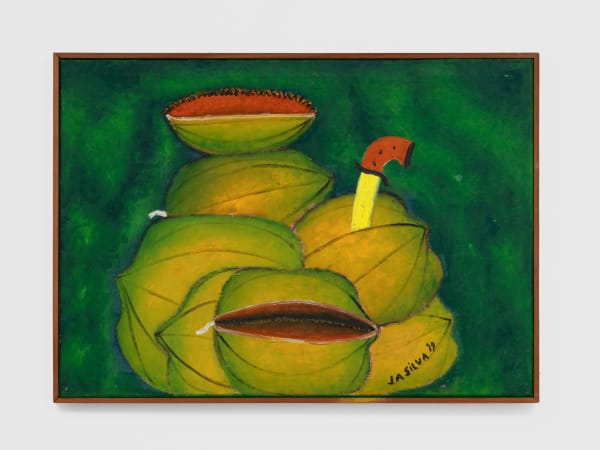José Antonio da Silva Brazilian, 1909-1996
An eccentric and charismatic figure with a distinct vision, Silva was the first self-taught artist from Brazil’s rural, labouring classes to have a marked impact on the nation’s modern artistic identity. Born in the São Paulo countryside to coffee farm workers, he began his career as an artist only at the age of 37, before this living a life of gruelling work and instability as a labourer on cotton, sugar and coffee plantations and railroads.
As a child, Silva had drawn on the backs of coffee leaves, and as an adult he drew with pencil on cardboard to decorate his home. In 1946, he entered a painting competition at the Casa de Cultura in São José do Rio Preto; as he could not afford canvases, he submitted three paintings on flannel. The jury, composed of critics Lourival Gomes Machado, Paulo Mendes de Almeida and philosopher João Cruz Costa - all closely connected to the modernist movements growing in São Paulo - nominated Silva for first place, though the organising committee overturned the decision. Nevertheless, this positive critical reception was to have a lasting effect on Silva’s career. He held his first solo exhibition just two years later at Galeria Domus, São Paulo, where ten works were acquired by Pietro Maria Bardi for the collection of the newly founded Museu de Arte de São Paulo Assis Chateaubriand (MASP). In 1951, he participated in the first edition of the São Paulo Bienal.
Silva maintained a complex relationship with Brazil’s art institutions throughout his career. Though his work was often branded ‘primitive’ or ‘naif,’ due to his social background and lack of artistic training, his consistent presence in the country’s leading museums, including MASP, Museu de Arte Moderna de São Paulo (MAM-SP) and Museu de Arte Contemporânea da Universidade de São Paulo (MAC USP), reflects his central position during of the development of Brazil’s modern artistic culture. Silva exhibited at the 1952 and 1966 Venice Biennales, and his influence on key players in Brazil’s art world is known; the master painter Alfredo Volpi had Silva’s work hanging in his studio, and the influential critic Theon Spanudis was one of his major collectors. However, his exclusion from the 4th São Paulo Bienal in 1957, and later his minimal appearance in 1967’s edition, provoked anger from the artist, leading to the production of multiple paintings attacking the organisation, branded with words such as ‘Odeio as Bienais [I hate Biennials].’ Dissatisfied with the major city institutions, he founded the Museu Municipal de Arte Contemporânea in São José do Rio Preto in 1968.
Silva’s career began in tandem with a period of richly diverse and collaborative artistic production in Brazil, with the fusion of US-imported abstraction and local visual languages advancing a distinctly Brazilian pathway within modern art. At the time he started painting, Brazil was also undergoing great social change, and Silva witnessed rapid industrialisation and changing labour laws throughout his early adulthood in São Paulo state, the centre of the coffee trade. Working alongside artist groups centred around Rio and São Paulo’s institutions, Silva contributed a unique perspective, maintaining his idiosyncratic style and focus on work and leisure in the countryside throughout his long career. The agricultural landscape prevails as his most captivating subject, with his characteristic use of perspective and high horizon lines bringing focus to the earth, both a land of riches and one forever reshaped and exploited by industry. Often foregrounding labourers or depicting scenes of celebration and rest in the country, Silva embodies a Brazil beyond the wealth of the cities, one saturated with the colours of nature, of red soil and verdant fields, and rich in spirit.
At Frieze Masters, 2024, Cecilia Brunson Projects shares the first solo presentation of Silva’s work outside Brazil. This precedes the artist’s first international solo exhibition at the Musée de Grenoble (2025), travelling onward to the Fundação Ibêre Camargo, Porto Alegre, Brazil. Silva has participated in significant international group exhibitions including Histoires de Voir, Cartier Foundation, Paris (2012), Art in Latin America, Hayward Gallery, London (1989) and the important exhibition of Brazilian modernism Brasilianische Kunst der Gegenward (Brazilian Art Today) touring Europe and Brazil in 1959. He participated in the Venice Biennale in 1952 and with a dedicated room in 1966. His work is held in major Brazilian collections including MASP, MAC-USP and Pinacoteca de São Paulo, as well as the Detroit Institute of Arts, Michigan (gift of Henry Ford II).



![José Antonio da Silva, Queimada [The Burning], 1971](https://artlogic-res.cloudinary.com/w_600,c_limit,f_auto,fl_lossy,q_auto/artlogicstorage/cbprojects/images/view/0814d1bf5d8db20a3ac91669c7112f97j.jpg)
![José Antonio da Silva, Trem [Train], 1977](https://artlogic-res.cloudinary.com/w_600,c_limit,f_auto,fl_lossy,q_auto/artlogicstorage/cbprojects/images/view/bc262ed33df999a41797d61e62ee9bd3j.jpg)



